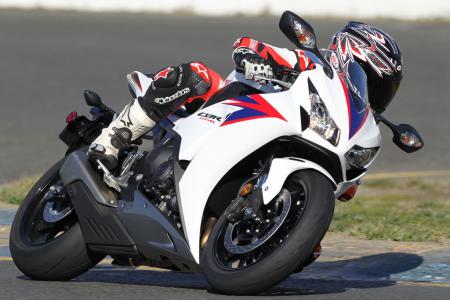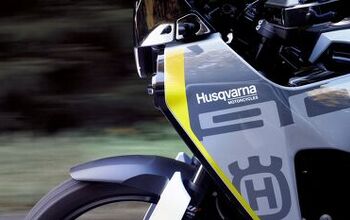2012 Honda CBR1000RR Review [Video] - Motorcycle.com
If it weren’t for the reshaped, more angular front end, you probably wouldn’t have known that the Honda CBR1000RR you see here is new for 2012. The truth is, you’re half right. While a few of its competitors have forged ahead with new versions of their flagship literbikes, including traction-control systems and other assorted electronics, Honda has forged ahead with the tried and true CBR1000RR that’s remained relatively unchanged since 2008.
So what’s different on the 2012 model? The most noticeable difference is its front end. Instead of the stub-nose front fairing, criticized for looking like someone who got punched in the face, the new model has a comparatively pointed front section which needs to be seen in person to fully appreciate. Honda also claims the new bodywork has been tweaked slightly in the form of a “layered fairing” to improve cooling.
The next visual clue this model is different are 12-spoke wheels that replace the three-spoke design of past models, which gives the CBR a much more striking appearance.
Honda says the new wheels are stiffer than before and thus improve rider feedback, but it wasn’t highlighting the fact these hoops suffer a combined weight gain of nearly 1 pound. However, our rep emphasizes the additional weight comes almost entirely from the hub sections, thereby minimizing its effect on rotational inertia. Indeed, after testing them back to back, I couldn’t notice a difference in its agility.
After that, the visual clues become harder to spot. Of note, however, is the upgraded suspension at both ends. The desirable Showa Big Piston Fork seen on supersports from both Suzuki and Kawasaki now grace the Honda. Out back is what Honda calls a “balance-free” rear shock, also from Showa.
The significance of this new shock is best explained by the pictures and graphs, but in essence, on the 2011 shock, during the transition from full extension to full compression there was a small dead zone as the shock reached its mid-way point. This momentary pause lasts a fraction of a second, but also compromises rear traction, however minute that difference might be.
The balance-free shock eliminates this dead zone, as the shock now damps in a smooth, linear curve across its entire stroke which improves rear grip and keeps the rear end more composed under aggressive riding.
The Glaring Question: Where Are The Electronics?
For those hoping the new CBR would come with fancy electronic rider aids derived from MotoGP like traction control or a seamless-shift transmission, it doesn’t. You’ll have to settle for a freshened-up gauge pack of the LCD variety, similar in scope to the RC51 from a decade ago. Only this one is slightly more advanced, featuring a programmable tachometer and shift lights. Its display is also clearer and easier to read than that on the RC51.
When asked why the new CBR doesn’t feature TC, Honda reps say the company’s philosophy isn’t to merely add a feature simply because it’s fashionable. Corporate speak or not, it’d be foolish to think Honda isn’t currently testing electronic rider aids, and it’s a safe bet that we’ll see a sophisticated electronics package, along with other major upgrades, when the CBR1000RR finally does receive its significant overhaul, perhaps in 2014.
Electronic improvements on the new CBR consist of revised fuel mapping to address one of the few complaints Honda received about the old version. Apart from that minor improvement, the engine remains the same torque-happy unit we’ve enjoyed since 2008, with no reports of horsepower increases or other advancements.
C-ABS returns as an option on the 2012 CBR, this time tuned to provide less front-end braking when the rear is applied. It’s important to note that only the rear brake is linked to the front, so clamping down with your right hand instead of your right foot won’t activate the rear binder. A 26-pound weight penalty is the price you pay for such technology, though lighter versions — as little as 5 pounds — are currently being tested by factory race teams worldwide.
A Step Forward
To judge for ourselves the significance of these improvements, Honda invited the moto press to Sonoma, California, to put the new CBR1000RR to the test around Infineon Raceway and also the surrounding streets. As an added bonus, and to confirm the press-kit hype, we were able to ride a few 2011 models back-to-back to really feel the differences in fueling and suspension responsiveness.
My first impression upon spinning some laps on the 2012 model was, “This doesn’t feel much different.” Engine power as well as stopping power from the dual 320mm discs and radial-mount Tokico four-pot calipers remain unchanged. The new CBR is quick to switch direction, and does so with minimal effort, but then again, so did the old one.
The solution, I figured, was to ride both of them harder. I blame my timid riding in the morning to the cool December day in northern California. Ambient temps were pretty chilly and some fog cover had made its presence felt in the morning. This made for cool track temps and limited visibility. The first issue proved to be inconsequential thanks to the superb Dunlop D211 NTEC rubber — the same tires used in AMA racing — Honda fitted for the track portion of our test. Standard tires are either the Dunlop Qualifier Q2 or Bridgestone’s new Hypersport S20. Adhesion levels were high, and the few slides I had from the front were completely predictable. There wasn’t much I could do about the vision issue but wait for the fog to clear.
Once it did, riding the old and new CBRs with more intent became a much easier task. The first thing I noticed was the new model’s composure under braking. With the BPF front end, charging corners hard on the brakes results in far less drama compared to the standard cartridge forks on the old model. As I’m not the smoothest braker anyway, it was nice to know my sloppy braking wouldn’t upset the chassis as much anymore.
As I never had much of a complaint about the old shock on the CBR1K, I’ll admit it was difficult for me to tell a difference with the balance-free unit. However, an area I did notice a tiny difference was under acceleration exiting slow-speed corners, as I had a better understanding of my rear grip exiting Infineon’s tight chicane. For me, the feature I like best about the new shock is its ease of adjustment compared to some traditional shocks. Both compression and rebound clickers are easily accessible from the external reservoir.
Fueling at slight throttle openings indeed is improved over last year’s model. Again, this is best noticed exiting slow-speed corners, especially after riding both bikes back to back. A slight hesitation when cracking the throttle on the old bike is now supplanted by power application in a smooth, linear fashion.
A gear indicator has finally been added to the instrument cluster at the request of customers. While definitely a welcomed feature, its presence is tucked away in the left corner of the display and is difficult to see at a glance. Inspired by the gauge cluster of the RC213V MotoGP machine, the new LCD display is easier to read than previous versions — even in harsh sunlight — but I still personally prefer to view an analog tachometer through my peripheral vision.
That said, the new display is filled with new features including lap timer, with a fastest-lap recall mode, five-level programmable shift lights, fuel consumption, and four different tachometer displays. A rider can change the way the bar graph on the tach reads, counting from left to right or right to left, and it includes a bar indicator of the highest revs reached during a trip. The new dash is definitely trick but can also be a bit overwhelming at first.
Race Inspired, Street Friendly
We’ve long been fans of the CBR1K on the street as its abundance of mid-range grunt is far more useful during the everyday grind. Sure, peak horsepower is impressive on paper, but accessible power is king on the street. Now with the improved throttle response at slower speeds, the CBR has further cemented its gentle giant status for the street.
An overnight rain shower left the roads of our street ride wet, and this presented a good test of the CBR’s slow-speed fueling. After riding both the 2011 and 2012 models back-to-back, the difference is definitely noticeable. Like at the track, power delivery is more linear on the new machine — though this would be difficult to notice if I hadn’t ridden the old model immediately before.
Another subtlety between the 2012 and 2011 is the suspension. None of the settings for either model were changed from our track ride the day before, yet the BPF and balance-free shock provided a stiffer ride compared to the suspenders on the old CBR. It’s an interesting phenomenon a few other journos noticed as well. Thankfully, a smoother ride is available via a few turns of the adjusters.
Ergonomically, the 2012 CBR is unchanged from the previous version. Featuring one of the more upright ergo packages in the literbike market, the ride could arguably be deemed “comfortable.” There’s plenty of room in the saddle for my five-foot, eight-inch frame to move around, though I did notice the seat was unusually slick — something I’ve noticed on past CBRs as well, both 600 and 1000.
Riding at slower street speeds makes noticing the gear indicator easier. In fact, the entire dash layout is easy to read. Though, just as it was at the track, it’s difficult to determine the engine speed with just a cursory glance.
Honda had just six new models available for the 12 journos at the event, forcing the other six to alternately ride last year’s versions. Of those, two were ABS models (which come only in red). In my limited time on the ABS model, I noticed I could confidently use more rear brake, free of concern for it locking. This could be felt by a greater amount of squat when slowing. Despite the fact the C-ABS adds 20-some pounds, it doesn’t notably slow its handling and provides a nice safety net when braking on slick roads.
The Everyman’s Superbike
When designing the 2012 CBR1KRR, Hirofumi Fukunaga, the Large Project Leader for the CBR900/1000 line for many years, had a simple goal in mind: to create “a supersport bike for everybody.” It had to appeal to seasoned riders as well as those new to liter-class power. In fact, since the first CBR900RR was introduced in 1992, 445,280 CBR900/1000s have been produced with that very goal in mind.
This latest iteration without question hits the mark. While not ground breaking or Earth shattering as far as new model updates go, the combined package of revised fueling and upgraded suspension enhance what was already a great all-around literbike.
The 2012 CBR1000RR retails for $13,800 (add another grand for the C-ABS version) and is available in red, black or the HRC-inspired pearl white/blue/red, It’s scheduled to hit dealerships at the end of January 2012.
Related Reading
2012 Honda CBR1000RR Preview
2012 Yamaha YZF-R1 Review
2012 KTM RC8 R and RC8 R Race Spec Review
2012 BMW S1000RR Review
2010 Honda CBR1000RR C-ABS Review
2010 Literbike Shootout: RSV4 R vs S1000RR vs. CBR1000RR vs ZX-10R
2009 Literbike Shootout
2008 Honda CBR1000RR Review
More by Troy Siahaan









































Comments
Join the conversation